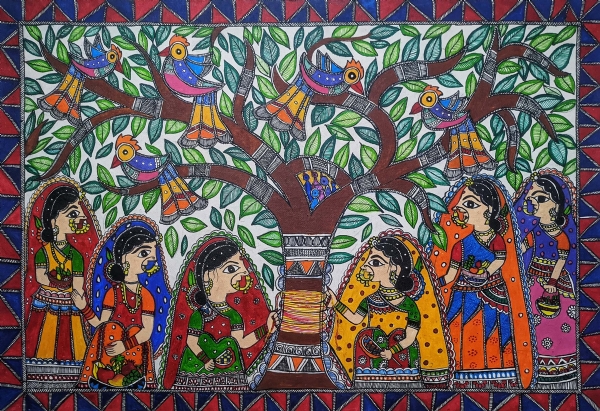Under the ' Akshayvat ' Echoes Eternal Bharat
The significance of Akshayvat is not limited to mythology. Ayurveda reveres it as a “complete pharmacy.”
Total Views |
On the bright morning of Vat Purnima in any town in Maharashtra, you will see women clad in beautiful sarees circling old Banyan tree's thick trunk, tying sacred threads with prayers on their lips. To an onlooker, it may seem like an age-old ritual, but beneath this act lays the timeless wisdom of Sanatan Dharma, that sees the Banyan tree as 'Akshayvat', the immortal, ever-giving symbol of life, resilience, and cosmic order.

The story of Akshayvat isn’t confined to one festival or one region. It is a living philosophy that has shaped Indian culture and thought for millennia.
The Tree That Defied Death
The very name Akshayvat means “the inexhaustible Banyan.” Legends say that when the great cosmic dissolution (Pralaya) occurred, leaving the universe submerged in water, only one living symbol remained, the little Bhagwan Krishna floating on a Banyan leaf. In that tender image, the eternal cycle of life, death, and rebirth was captured, anchored by the leaf of Akshayvat.
Later, the Mahabharata tells of Bhagwan Krishna revealing the Bhagavad Gita’s wisdom to Arjuna beneath a Banyan tree in Jyotisar. The Ramayana speaks of Panchavati, where five sacred Banyans stood witness to Rama and Sita’s forest sojourn. Even in the Upanishads, the Banyan is a metaphor for the universe, with roots above and branches below, symbolizing the connection between the material and the spiritual.
How did a single tree come to represent such vast truths?
A Living Symbol of Sanatan Dharma
The 'Sanatan Dharma' that is India’s eternal way of life is more than just temples and rituals. It is also about seeing divinity in the natural world. The Banyan tree exemplifies this ethos.
In the Banyan’s structure lies a cosmic story. Its aerial roots descend to the earth, taking root again and forming new trunks, endlessly regenerating. It is a living embodiment of 'Akshaya', that which never diminishes. It is no wonder that Hindu scriptures proclaim:
"Vatamule sthito Brahma, vatamadhye Janardanah, vatagre tu Shivo devo, Savitri vata samsthita."
(At the root dwells Brahma, in the trunk Vishnu, at the front Shiva, with Savitri under its canopy.)
Thus, worshipping the Banyan is akin to honouring the entire Trimurti that represents creation, preservation, and dissolution in perfect balance.
Savitri’s Resolve: The Feminine Spirit Meets Akshayvat
Among the many stories intertwined with Akshayvat, the tale of Savitri and Satyavan shines the brightest. When Yama, the god of death, came to claim her husband, Savitri’s unyielding love and wisdom compelled him to restore Satyavan’s life. She performed her penance beneath a Banyan tree, invoking the eternal spirit of Akshayvat as her ally.
This is why, to this day, during Vat Purnima, married women perform rituals under the Banyan to pray for their husband’s long life and the eternal bond of marriage. The tying of sacred threads symbolizes their wishes woven into the fabric of life itself, seeking continuity, strength, and protection.
But deeper still, this ritual honours feminine strength, resilience, and the eternal nurturing spirit—values that resonate across generations.
A Natural Pharmacy and Environmental Guardian
Akshayvat’s significance is not limited to mythology. Ayurveda reveres it as a “complete pharmacy.” Each part of the Banyan offers healing:
Bark: Cools the body, treats wounds, stops bleeding.
Leaves: Cure skin infections, joint pains, and promote healing.
Roots & Aerial Prop Roots: Manage diabetes, aid digestion, nourish hair.
Latex (milky sap): Heals mouth ulcers, treats piles, and strengthens gums.
Fruits: Boost serotonin, helping fight anxiety and depression.
Akshayvat reminds us that ancient nature-based healing still holds power.
Moreover, from an ecological standpoint, the Banyan is a keystone species. Its vast canopy provides shelter to countless birds, bees, and small mammals. It produces oxygen abundantly, improves air quality, and supports biodiversity. A mature Banyan can release up to 700 kg of oxygen daily, that evidently proves the tree to be counted as nature’s unmatched air purifier.
In both urban and rural landscapes, the Banyan acts as a micro-climate regulator as it cools the environment and also preserves groundwater levels. Its roots prevent soil erosion, making it a natural guardian of the land.
A Bridge Between Past and Future
For today’s youth navigating a fast-paced digital world, ancient rituals might seem irrelevant. But Akshayvat teaches timeless lessons:
Resilience: Like the Banyan’s aerial roots finding new ground, we too can adapt and grow through life’s trials.
Interconnectedness: Just as the Banyan supports an entire ecosystem, humans thrive only when in harmony with nature.
Balance: The Trimurti symbolism reminds us that creation, preservation, and dissolution are natural cycles to embrace, not resist.
Feminine Strength: Savitri’s story urges us to honour courage, love, and moral conviction, values as vital today as ever.
Akshayvat reflects Sanatan Dharma’s vision of life, that is eternal, regenerative, and deeply connected to nature. The next time you walk past a Banyan, wait. Look at its expansive canopy, the roots reaching down like arms of wisdom. Here stands the witness of countless generations, inviting us to root ourselves in values that never fade.
While the modern world battles climate change, mental stress, and spiritual emptiness, Akshayvat calls us back to an ancient truth: when we live in harmony with the eternal cycles of nature, we too become timeless.
--

